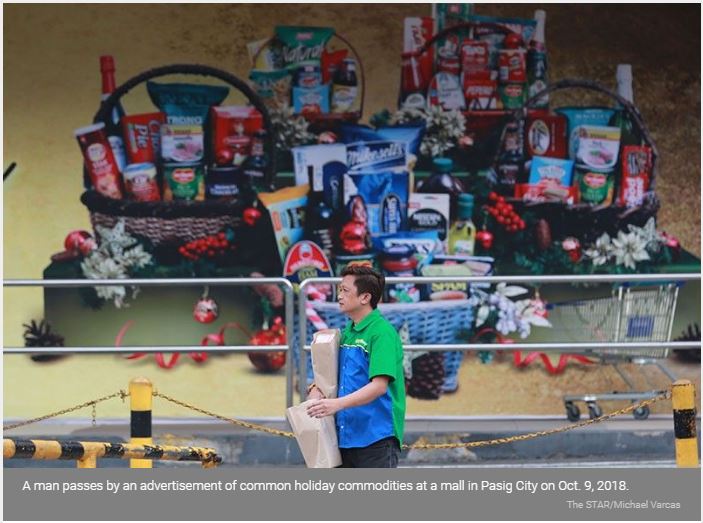Philippines: Inflation cools down for the first time in 2018 in November
MANILA, Philippines (Updated 1:34 p.m.) — Philippine consumers reeling from soaring prices finally got their much-awaited reprieve in November, which saw a softer inflation print on the back of slower price increments for food and tumbling oil prices, the country’s statistics agency reported Wednesday.
Inflation cooled down to a four-month low of 6 percent in November from the previous month’s 6.7 percent, which was the highest in almost a decade.
This is the first time in nearly a year that surging prices eased. Seasonally adjusted inflation dropped 0.3 percent in November from October — the first such decline since February 2016.
But in the first 11 months, inflation averaged 5.2 percent, 1.2 percentage points above the high end of the Bangko Sentral ng Pilipinas’ 2-4 percent target range and among the highest in Asia.
Broken down, food prices moderated in November, showing signs that the Duterte administration’s efforts to ease food supply bottlenecks are starting to work. Steep falls in global oil prices also fed through to domestic prices, although transport costs spiked last month as a result of fare hikes.
In a statement, central bank governor Nestor Espenilla, Jr. said the latest inflation figure was “very encouraging.”
“Strong monetary action has significantly reinforced the anti-inflation process through the expectations route and a firmer peso. However, its more direct impact on economic activity will take longer time to take hold,” Espenilla said.
In a bid to temper consumer demand that likely lifted prices, the BSP has delivered rapid-fire interest rate hikes of 1.75 percentage points since May, among the most forceful increases in Asia.
Stubbornly high inflation and surging borrowing costs have weighed on consumer spending, which has traditionally been the driving force behind growth, and crimped economic expansion to a three-year low in the third quarter. The central bank will meet to review rates on December 13.
With inflation seen abating moving forward, the BSP can now afford to slash lending rates as early as the second quarter of 2019 on top of the expected cut in reserve requirements to help the economy reverse its weakening growth momentum, said Nicholas Mapa, senior economist at ING Bank in Manila.
Separately, London-based Capital Economics said key rates are projected to remain on hold at 4.75 percent throughout 2019, and that the BSP will begin to loosen policy in early 2020.
For ANZ Research, the latest data reinforces its view that inflation has peaked in the Philippines and that the central bank now has a room to keep policy rates steady next week.
‘Pay close attention’
Despite the deceleration in headline inflation, Espenilla stressed the need to “pay close attention” to core inflation trend, which continued its uptick in November.
“Monetary policy will need to stay vigilant to keep inflation under firm control amid expected strong economic growth,” the central bank chief said.
Excluding items with volatile price movements, core inflation — often used as an indicator of long-term inflation trend — accelerated to 5.1 percent the last month from 4.9 percent in October, government data showed.
Noting the spike in November core prices, HSBC economist Noelan Arbis said “inflation pressures have not completely dissipated.”
“Continued above-trend increases in core prices would suggest growing demand-side price pressures,” Arbis said, adding that the BSP may not be done jacking up rates just yet.
“We expect a 25-basis point rate hike to 5.00 percent in first quarter of 2019 in response to the tax increases in January, which poses the risk of stoking further inflationary pressures and higher inflation expectations,” he said.
Source: https://www.philstar.com/business/2018/12/05/1874421/inflation-cools-down-first-time-2018-november#kZJZkz3Pa0TbM1UM.99


 Thailand
Thailand




